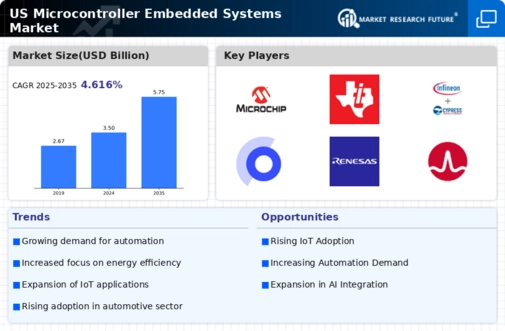Focus on Energy Efficiency
The growing emphasis on energy efficiency is a crucial driver in the microcontroller embedded-systems market. As industries and consumers seek to reduce energy consumption and lower costs, the demand for energy-efficient microcontrollers is increasing. In 2025, the energy-efficient electronics market is expected to reach $200 billion, highlighting the importance of microcontrollers in developing sustainable solutions. These devices are designed to optimize power usage, thereby extending battery life in portable applications and reducing operational costs in industrial settings. This focus on energy efficiency not only benefits end-users but also aligns with global sustainability goals, further propelling the microcontroller embedded-systems market.
Rising Demand for Smart Devices
The increasing consumer preference for smart devices is a pivotal driver in the microcontroller embedded-systems market. As households and businesses adopt Internet of Things (IoT) technologies, the need for efficient microcontrollers becomes paramount. In 2025, the smart home market is projected to reach approximately $100 billion, indicating a robust demand for microcontroller solutions. These devices facilitate connectivity and automation, enhancing user experience and operational efficiency. Consequently, manufacturers are compelled to innovate and integrate advanced microcontroller technologies into their products. This trend not only boosts the microcontroller embedded-systems market but also encourages the development of new applications across various sectors, including healthcare, security, and energy management.
Advancements in Automotive Electronics
The automotive sector's transformation towards electrification and automation significantly influences the microcontroller embedded-systems market. With the rise of electric vehicles (EVs) and advanced driver-assistance systems (ADAS), the demand for sophisticated microcontrollers is surging. In 2025, it is estimated that the automotive electronics market will exceed $300 billion, with microcontrollers playing a crucial role in vehicle functionality and safety. These components are essential for managing various systems, including powertrain, infotainment, and safety features. As automotive manufacturers increasingly prioritize innovation and sustainability, the microcontroller embedded-systems market is likely to experience substantial growth, driven by the need for reliable and efficient electronic solutions.
Integration of Artificial Intelligence
The integration of artificial intelligence (AI) into embedded systems is emerging as a significant driver for the microcontroller embedded-systems market. AI capabilities enhance the functionality of microcontrollers, enabling them to perform complex tasks and make real-time decisions. This trend is particularly evident in sectors such as healthcare, where AI-driven devices can monitor patient conditions and provide critical data analysis. By 2025, the AI in the embedded systems market is projected to grow at a CAGR of over 20%, indicating a strong demand for microcontroller solutions that support AI applications. This integration not only improves efficiency but also opens new avenues for innovation within the microcontroller embedded-systems market.
Expansion of Wireless Communication Technologies
The rapid expansion of wireless communication technologies is significantly impacting the microcontroller embedded-systems market. With the proliferation of 5G networks and enhanced connectivity solutions, the demand for microcontrollers that support wireless applications is on the rise. By 2025, the wireless communication market is projected to surpass $1 trillion, indicating a robust growth trajectory. Microcontrollers are essential for enabling seamless communication between devices, facilitating the development of smart cities, connected vehicles, and industrial IoT applications. This trend not only drives innovation within the microcontroller embedded-systems market but also fosters collaboration across various industries, enhancing overall technological advancement.
















Leave a Comment